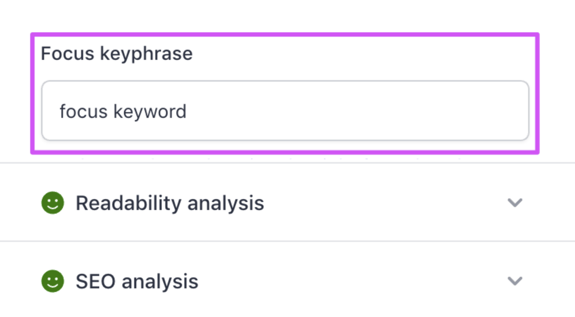If you already have Yoast installed on your WordPress website, you’ve seen the cute li’l happy, meh and sad faces staring back at you…judging you. Yes, this is meant to improve your SEO efforts through gamification, but for some type A tech marketers the pressure to attain all green bullets is an unnecessary stressor that may actually be hurting your rankings instead of helping them.
(Hint: robotic writing and keyword stuffing to appease Yoast’s grading system = bad.)
So when do you know when it's okay to channel your inner Elsa and let it go? We'll explore that in this article, along with the times when following Yoast’s suggestions is exactly what you should do.
What is Yoast exactly?
Yoast is an extremely popular SEO plugin for WordPress (and Shopify), with over 8 million installs. Its free version recognizes “related keyphrases, synonyms of keyphrases, and different word forms of your keyphrases" to analyze your content for SEO, helping you improve search engine rankings over time. If you upgrade to the premium version (currently $99/year), you’ll also be able to automatically redirect pages, access 24/7 support, take all of their training courses and more.
Once installed, Yoast will prompt you to enter a focus keyphrase for each page on your website. Then, it will assign each page a "grade"—a red, yellow or green smiley face—for both readability and SEO. If you expand these sections, you'll see what individual factors have contributed to that grade with red, yellow or green bullets next to each specific criteria.
Why can Yoast be problematic for tech companies?
Green bullets do not guarantee your keyword is “good”
While Yoast is an excellent tool, it's meant to be a guide and not the be-all, end-all SEO expert. At its core, the plugin simply analyzes your content based on the phrases YOU enter into the focus keyphrase field. In other words, the tool isn’t choosing keywords for you…it’s only telling you how well you’re using them on each page. That means the responsibility of good keyword research still lies with you! After all, green bullets won’t substantially increase organic traffic if your chosen keyword is only getting 10 global searches each month.
The pursuit of green bullets can lead to a bad user experience
Turning all of Yoast's bullets green doesn’t mean you’ll rank #1 for your keyword. Yet psychologically, we know it huuurts to leave any of them yellow or red, even if common sense tells you it's okay.
In the end, Yoast itself suggests toning down the A+ yearning and focus on simply getting green smiley faces for readability and SEO vs. trying to achieve green dot perfection in every subcategory.
When should tech marketers ignore Yoast?
Short answer: when common sense tells you to. Here are some of the most common scenarios when it’s acceptable (and often better!) to not get that green dot.
When there’s no need for lots of content
Yoast recommends over 300 words on a page, but on a basic Contact Us page this may not be realistic. Are you going to add in fluff just to meet that threshold? No! That won’t benefit your end user and may actually decrease conversions and increase bounce rate.
When there’s no need for keyword optimization
Let’s be honest: you don’t need your legalese privacy policy page to rank for anything on Google. Just stick to what the lawyers need to say and call it a day. In fact, trying to get it to rank might cause it to compete with other more important pages on your website, leading to keyword cannibalization. (Scary, right?)
When there’s no need for outbound links
Citing a source? Sure, you should 100% link to that webpage. But on your pricing page??? This bottom of the funnel, high intent page is not the time to send interested parties elsewhere for the sake of a green dot! You’ve got them right where you want them, keep them there.
When your keywords don’t make sense in an image alt tag
If an image lives on a webpage to add graphical interest, break up content or as a background image, it doesn’t need a keyword rich alt tag. It’s not likely that your perfect user is searching “tech pattern.” But just because you’re skipping the keyword alt tag, doesn’t mean you don’t have to optimize the image. Compress it, resize it, upload it as the correct file format so that your site is as speedy as can be.
When lists are better than paragraphs
Especially in tech, bulleted or numbered lists are necessary for listing off features, steps or specs. Writing these out as full paragraphs would be a snoozefest and wouldn’t highlight the awesomeness of your product or platform! When you create a list, it’s natural for the first word to be the same here and there. The consecutive sentences bullet may ding you for this but it’s all good because your visitors will be happy you check all their boxes.
When should tech marketers listen to Yoast?
At this point, we sound like we’re Yoast haters…but that couldn’t be further from the truth! We use this plugin on all of our WordPress websites and will always shoot for green bullets on the following must-have items:
- Keyphrase in meta description
- Meta description length
- SEO title width
- Subheading distribution and hierarchy
- URL structure
What does this mean for tech marketers?
By now, you hopefully understand that Yoast is an extremely useful SEO tool, but that its color-coded grading system should be taken with a grain of salt. After all, a "perfect score" with all green bullets doesn't guarantee you a #1 Google ranking.
Moral of the story? When creating content, think like your end user—what content do they want to read, what action should they take—over writing for a plugin.







